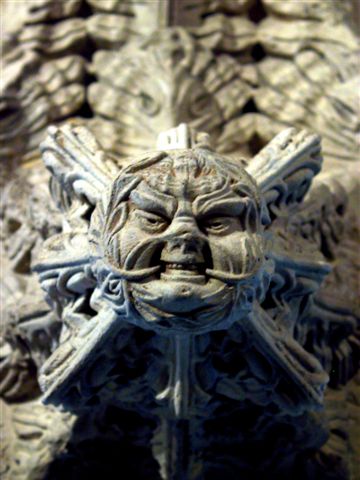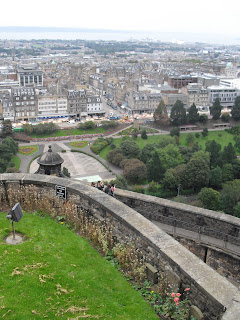(One of the green men of Rosslyn Chapel, via Wikipedia.)
Last weekend, Nana and I joined the International Student Centre for a trip to nearby Roslin, home of the famous Rosslyn Chapel.
Rosslyn Chapel, made ultra-famous by its recent role in Dan Brown's The DaVinci Code, is one of those tourist attractions you kind of assume won't live up to the hype. But it does, and then some.
Rosslyn Chapel is notoriously full of surprises, but our first surprise came before we even went in: as it turns out, the current Barons of Roslin are Erskines, which makes them Nana's (very) distant cousins. A whole bunch of them are buried throughout the churchyard.
The other surprise was that, owing to the massive restoration project, there was a catwalk around the exterior of the roof, which was open to visitors.
The catwalk allowed for up-close inspection of the original stone (the stone inside the chapel is hidden behind a layer of concrete, foolishly applied by those silly Victorians).
As you can see, the chapel is actually multi-hued. It's made of a variety of local sandstones--red, gray, yellow, and grayish-green.
Photography is off-limits inside the chapel, but you can get a sense of the space by looking at some of the photos here. The chapel is a wunderkammer of late-medieval masonry, with nearly every surface in the chapel elaborately carved.
I won't go into the history of the chapel too deeply (if you're interested in more, check out the official website), just enough to tease out some of the many mysteries of the place. Originally built by a Norman knight named Sinclair in the mid-15th century, the chapel is a strange mishmash of Christian iconography, pagan Celtic imagery, and Masonic symbolism, with some references to the Knights Templar thrown in for good measure.What's more, even though construction on the chapel stopped around 1450, several carvings depict New World plants (the giant arch of corn--called "maize" in these parts--being the most obvious), which seems to support the Sinclair/St. Clair family myth that the grandfather of Rosslyn's founder had traveled to Newfoundland and Labrador sometime around 1430.
Naturally, the place is a conspiracy theorist's dream, and some of the wilder speculations name Rosslyn as the final resting place of the Holy Grail, the True Cross, and any number of other Catholic relics. This speculation is cannily encouraged by the St. Clair Erskines, Rosslyn's current proprietors, who have resisted attempts to open the chapel's enormous vaults--at least, that is, until the renovations are done.
Anyway, if you're in Edinburgh, don't let the hype scare you off: go to Rosslyn Chapel.
But while you're there, don't forget to explore the rest of Roslin Glen. Just down the hill from the chapel are the ruins of Roslin Castle (the current seat of the St. Clair Erskines is nearby), a tower of red sandstone looming out of a deep, wooded gully.
You can follow a short trail down some steps to the foundation of the castle, which was apparently a favorite spot of good old Rabbie Burns.
Roslin Glen is also a great illustration of one of the signature quirks of the Scottish landscape: anything exposed to the wind is swept nearly barren, left to gorse and heather, while the sheltered glens are almost like cool, wet jungles. Check out, for example, the moss growing on this tree:
So that's all the sightseeing for now. I'll try to get Nana to post something about her classes. And something tells me there might be some expat pumpkin carving in the offing . . . stay tuned!






















 (That's Edinburgh Castle at the top, Yale below).
(That's Edinburgh Castle at the top, Yale below).


 On second thought, no. It was too cold.
On second thought, no. It was too cold.